This working paper summarizes findings from a study, conducted as part of the WorldFish/USAID “Feed the Future-Aquaculture” project in 2012, assessing the current status of the aquaculture feed sector in Bangladesh. Fish feed value chains, market trends, ingredients and formulation systems, farm feeding practices, ancillary services and feed regulations were investigated. The study identifies a number of entry points for interventions in the sector, and investments which would improve feed quality and farmer access to better feeds and support the growth of sustainable aquaculture.
Background
The use of aquaculture feeds in Bangladesh has grown substantially in the past few years, and now over 1 million tonnes of commercial pelleted feed are being formulated for use by aquaculture farmers. An estimated further 0.4 million tonnes of locally-formulated and processed diets are also being prepared by small village-based feed-making enterprises. Rapid growth in use of formulated feeds has helped many aquaculture farmers intensify production, but at the same time has raised a number of issues including feed quality, feed management efficiency and environmental sustainability.
A study conducted during 2012 within the context of the WorldFish/USAID “Feed the Future- Aquaculture” project was specifically intended to provide guidance and direction on investments required in the feed sector of Bangladesh to support sustainable growth of aquaculture. Its main objectives were to understand:
- value chains for fish feeds in Bangladesh, and the roles and interactions amongst various actors within the chains;
- quality of feed ingredients and ways to improve this quality;
- fish feed production methods and demand for aquaculture feeds;
- fish feeding practices and ways to reduce feed wastage and improve feeding efficiencies;
- research and development needs for better fish feed formulation and utilization.
Methodology
The research team used various assessment tools—including FGD (focus group discussion), in-depth interviews, individual and key informant interviews with semi-structured questionnaires—to collect information from different stakeholders along the value chain. Information from each actor was validated by other actors relative to backward and forward value chain linkages. Secondary information from various sources was collected and reviewed. Life cycle analysis was conducted to understand the environmental dimensions of feed production within the country.
Findings from the research were presented to a workshop of more than 50 participants, representing a range of stakeholders involved in aquaculture feeds throughout Bangladesh. WorldFish hosted the workshop on 4 April 2013 at the Hotel Lake Castle in Dhaka; feedback and suggestions from workshop participants were incorporated into this paper.
Key findings
Fish feed value chains
Fish feed production and use in Bangladesh aquaculture has increased dramatically in the past 5 years, with an estimated 1 million tonnes of commercially formulated pelleted feed produced, and between 0.3 and 0.4 million tonnes of feeds produced by micro- and small-enterprises at village level. Feeding of fish with formulated diets has contributed to increasing intensity of production of major fish species such as Nile tilapia (Oreochromis niloticus), Pangas (Pangasianodon hypophthalmus), climbing perch (Anabas testudineus), major carps and others.
Value chains have developed in association with the growth of the formulated feed industry and now widely connect feed suppliers with farmers, though more remote farmers still lack access to formulated feed. Figure 1 shows the major actors and linkages in the fish feed value chain from ingredients to farmers. Bangladesh produces 50–55 per cent of fish feed ingredients, with the remainder imported. These products flow from producers or importers via feed processors to reach farmers through various channels. Some raw materials such as rice bran require processing in mills before incorporation into formulated aquaculture feeds.
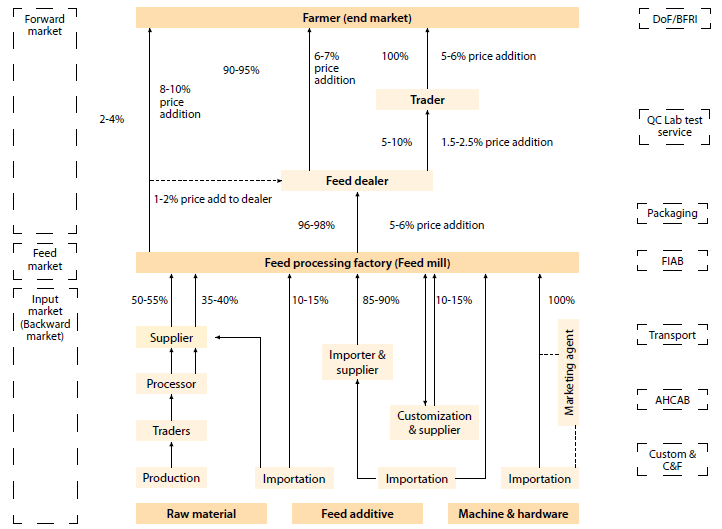
Various suppliers and traders deliver ingredients to feed formulators, although large and medium feed mills import directly, accounting for about 10–15 per cent of total raw materials used. Feed additives are imported, and traded through various channels. Machines used for feed processing are directly imported by feed mills with assistance of marketing agents from manufacturing companies. Feed dealers that distribute 96–98 per cent of feed from feed mills to farmers typically earn a commission of 6–7 per cent on buying price. The dealers distribute around 5–10 per cent of total feed to remote areas, or to small farmers, through other traders.
Major service providers include the Department of Fisheries (DoF), Bangladesh Fisheries Research Institute (BFRI), packaging industries, private and government laboratories, the Feed Industries Association of Bangladesh (FIAB), transport agencies, the Animal Health Companies Association of Bangladesh (AHCAB), customs, and clearing and forwarding (C&F) agents.
Figure 2 shows the proportion of the end price paid for feed by farmers according to each stage in the value chain, based on the average cost of raw materials, raw material processing costs, transport costs, other costs and profit margins for feed millers and dealers.
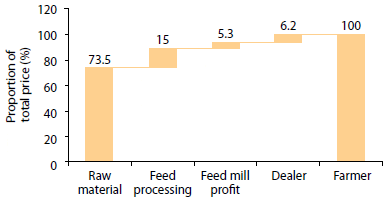
Fish feed ingredients and formulation
The main ingredients used for fish feed production are rice bran (20–50 per cent inclusion), maize (5–20 per cent inclusion), soybean meal (10–30 per cent inclusion), mustard oil cake (10–25 per cent inclusion), fish meal (5–15 per cent inclusion) and meat and bone meal (10–20 per cent inclusion).
Rice bran is mainly produced locally, and is derived from rice milling. It accounts for 7–8 per cent of unmilled paddy grain by weight. Three types of rice bran are used: de-oiled rice bran (DORB), grade A rice bran (comprising 85–90 per cent bran and 15–10 per cent husk), and grade B rice bran (comprising 60–50 per cent bran and 40– 50 per cent husk). The protein content of DORB and grade A rice bran is approximately 12–17 per cent and 10–13 per cent, respectively. Only 30 per cent of total rice bran production of Bangladesh is used for commercial animal feed production. Three main factories produce approximately 0.13 million tonnes of DORB per year during production of rice bran oil.
Local production of maize has reached 1.65 million tonnes, of which 90–-95 per cent is used for animal feed production, including 7–10 per cent for fish feed. The market for maize is mainly controlled by the poultry industry. The severe outbreak of avian influenza virus (H5N1) of poultry has in recent years depressed demand.
Soybean is mainly imported from South America, although around 150,000 tonnes of soybean was locally grown in Bangladesh (mainly Noakhali region) in 2012. The seed variety, price, and culture technology influence local production. Beans are used primarily for the extraction of soy oil. Soybean meal or cake, which is used in feed, is the byproduct of this process, accounting for 75 per cent of the unmilled bean by weight. There are currently three solvent extraction plants in Bangladesh which provide 34–38 per cent of the country’s total supply of soy meal/cake. The remaining 62–66 per cent is imported, mainly from India. Soybean meal/cake is typically included in sinking and floating fish feeds at rates of around 10–20 per cent and 20–30 per cent, respectively. The market is mainly controlled by two processing mills and Indian exporters.
Mustard and rapeseed belong to the same genus Brassica. The amount of erucic acid in mustard/rape seed determines the quality, and varies depending on species and variety. ‘Canola’ is a particularly high quality variety of genetically altered rapeseed which is a registered trade mark of the Canadian Oil Association and is increasingly available in Bangladesh. The meal/cake which used in feed is the byproduct of oil processing, accounting for 57-62 per cent of the unmilled seed by weight. The local production of mustard oil cake is 0.23 million tonnes, but the demand by the animal feed industry is almost 0.33 million tonnes. The same two soybean crushing mills import rapeseed (or canola) to meet the demand.
Local fish meal, which is manufactured from a variety of trash fish, crabs and other aquatic animals, is very variable in nutritional composition. During the drying process, large quantities of salt are added to aid long-term preservation. This has the effect of increasing the weight of dried fish by up to 20 per cent, which contributes profit to dried fish processors but undermines feed quality. More salt may be added intentionally for the purposes of adulteration, further compounding the quality problem. The crude protein content of meal derived from local dried fish varies from 35 to 45 per cent. The domestic source of better quality fish meal (44–52 per cent crude protein content) is the chewa (Pseudapocryptes elongates), supplied in southern Bangladesh in Kuakata and the islands of Hatia and Bohala, but amounts available are insufficient to meet the demand of the feed sector.
An approximate calculation indicates that the annual catch of fresh trash fish is close to 0.15 million tonnes; equal to approximately 0.0375 million tonnes of fish meal. Considering that most feed producers aim for at least 5 per cent inclusion of fish meal, this quantity of supply is insufficient to meet demand. As a result, fish meal is not included in all feeds, and imported analogue fish meal (a mixture of 50 per cent fishmeal and other protein meals such as blood meal, feather meal and meat and bone meal) is often used as an alternative ingredient. Possible competition between the use of marine fish for human consumption and in aquafeeds is a concern, given Bangladesh’s human nutrition challenges, but remains to be explored.
Meat and bone meal is utilized as a source of cheap protein (48–52 per cent crude protein) and is imported, particularly through Australia and Paraguay. There are two grades of meat and bone meal. Generally fertilizer grade is cheaper than feed grade, partly because it is subject to less strict custom regulations.
Imported raw materials contribute more than 50 per cent to the total cost of feed production in Bangladesh. Variations in the price of imported feed ingredients are linked with fluctuations in international markets, changing import policies, and external relations with exporting countries. Raw materials are generally supplied to feed mills by a number of distributors, but large feed mills open letters of credit which allow them to reduce costs by importing ingredients directly. There are almost 150 feed additive importers, suppliers, and traders; ten of those are representing different multinational feed additive companies. There are also five human medicine manufacturing companies that customize vitamin premix for local feed companies, but the raw materials required to manufacture these additives are imported. Sixty per cent of feed mills use growth promoters (antibiotic growth promoter and non-antibiotic growth promoter); among these only 24 per cent of feed mills use non-antibiotic growth promoters, indicating antibiotic contamination as a significant feed quality and food safety concern.
Fish feed production and market trends
Use of formulated feeds for fish farming is increasing in Bangladesh, associated with growth and intensification and commercialization of aquaculture. It seems that commercial pelleted feeds are starting to replace ‘farm-made’ and ‘raw’ unformulated feeds.
As indicated by Figure 3, production of commercial feeds has increased at an average rate of 32 per cent per year over the period 2008–2012, and has reached an estimated total of almost 1.07 million tonnes in 2012. Sinking feeds, which accounted for 81 per cent of total manufactured output, still dominate over extruded floating feed (19 per cent), but growth in the production of floating fish feed has been fastest, averaging 89 per cent over the last four years. Three types of floating feeds are available: oil coated, non oil-coated, and vegetable protein based. Non-oil coated feeds account for 95 per cent of total sales. Feed prices increased at a rate of between 9 and 15 per cent per year from 2008 to 2012, due to increases in the price of major raw materials and unavailability. The retail price of 3–4 mm grower feed is currently 35–42 BDT/kg for sinking pellet feed, and 48–54 BDT/kg for extruded floating feed, depending on the species. Using least square demand forecasting and Delphi methods, total feed production is projected to increase to nearly 1.8 million tonnes in 2015 (Figure 3).
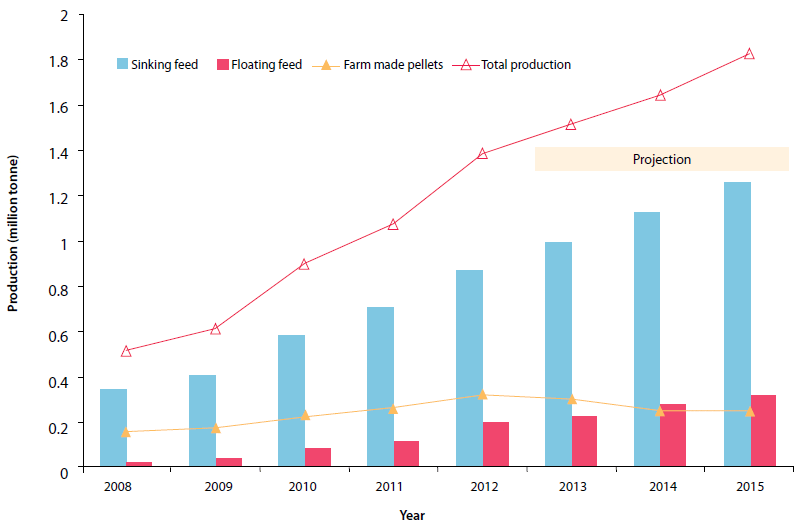
Around 100 commercial mills produce aquaculture feeds in Bangladesh. Among these, 8–10 large operators account for 60–70 per cent of market share. During the last two years, horizontal growth (expansion) of feed mill capacity was comparatively higher than in previous years. During the last two years, around 20 companies extended their capacities from 5 to 10 tonnes/hour, and 10 companies have installed extruders for floating fish feed production.
The number of farm-made pellet feed mills is difficult to estimate, but it can be safely assumed that they number more than 1,000. Feed mill machines can be easily manufactured in local workshops at a cost of BDT 100,000–250,000 (USD1250–3125), and produce 50–300 kg feed/hour. Operators of these types of machines often face difficulties with adequate pellet binding and drying, and lack the knowledge and awareness required to formulate feeds that provide sufficient nutritive value to fish at various growth stages.
Around 20 commercial feed mills in Bangladesh manufacture feed on a rental basis. These mills are most commonly used by large farmers to produce feed to meet their own requirements, and by feed traders who brand and sell this feed in the local area at relatively low cost. They customize their formulation and pricing depending on local farmers’ buying capacity. The rental or processing cost for use of these mills is 2–3 BDT/kg (USD0.03–0.04/kg) for sinking feed. Few extruders are available for rent, although there are 2–3 mills with extruders which charge 8–10 BDT/kg (USD0.103–0.128/kg) for producing floating fish feed. Low quality poorly performing feed from such facilities is a concern, due to limited knowledge on formulation.
Increasing vertical integration has recently been observed in the sector, with feed companies expanding the range of support services and inputs they provide to farmers and dealers in order to capture greater market share. Eight feed companies currently supply customers with feed and mono-sex tilapia fingerlings from their own hatcheries (a marketing concept which originated in the poultry industry). Two large industrial groups have already established vertically integrated operations encompassing hatchery, feed manufacture, grow out, and processing, although processing capacity is not fully met from fish produced by their own operations.
Due to temperatures and water availability, the main season for commercial fish culture generally starts from March and continues until November, so the greatest volumes of feed are produced from April to September. Feeds are formulated and/or branded for specific species in the following proportions: Pangas 60–65 per cent; tilapia 35–45 per cent; climbing perch 10–15 per cent; carp and other finfish 2–5 per cent; shrimp and prawn 2– 3 per cent. Of these feeds, nursery feeds (2.5 mm size) 60–70 per cent of the total. Extrusion technology is mainly used for producing floating feed for tilapia, which accounts for around 40–50 per cent of total tilapia feed production and retails for 7–10 BDT/kg (USD0.09–0.128/kg) more than sinking feed. The production rate of grower feed is 1–2 tonnes/hour greater than that of starter feed, while energy consumption in machine operation and protein inclusion costs are higher for starter feed than for grower.
The average price of 1 per cent protein in feed is 1.24 ±0.12 BDT. Processing losses in the factory vary from 0.7 to 1.0 per cent. Fuel costs for production of extruded floating feed are higher than those for sinking feed—at 2.14 BDT/kg and 0.71 BDT/kg feed, respectively.
Farm feed use and feeding practices
Large feed companies partner with around 450–500 dealers, medium-sized companies work with 200– 300, and mills with only regional coverage typically work with 20–100. Some dealers work exclusively for a single company, but most sell feed from several. Most companies provide credit to feed dealers, but small feed companies provide comparatively more credit than larger ones.
Farmers may also receive feed on credit from dealers, and the total quantity of credit extended from dealers to farmers is much higher than the amount received by dealers from feed manufacturers. When dealers extend credit to their customers they typically add an extra 1–3 per cent to the retail price, depending on the duration over which the credit is extended and the characteristics of the customer.
Use of commercial pelleted feed is now very common among farmers practicing commercial fish farming, with feed costs commonly accounting for 70–75 per cent of farm operating costs. Farmers commonly feed their fish twice daily by broadcast feeding, but feed requirements are rarely measured properly (according to body weight) through timely sampling. Floating feed users are better able to measure feed requirements through observation of fish behavior, and feeding to satiation. Feed conversion ratios (FCRs) for floating pelleted feed are comparatively lower than for sinking pellet feed: approximately 1.5 vs 1.85 for tilapia and 1.6 vs 2.0 for pangas, though both could be improved by reducing wastage.
Services
Feed value chains incorporate a range of service providers, including those involved in transport, packaging, machinery, quality control and information services.
Transport: Feeds and feed ingredients are transported over long distances by truck, both within Bangladesh and from India. Transport agencies provide services with the cost of truck transport for feed, raw materials etc. ranging from 0.006 to 0.012 BDT/kg/km. Sufficient transport is available to support the feed sector.
Packaging: Packaging is crucial for distribution of formulated feed as it protects from moisture, insect infestation and related problems. The standard bag for 25 kg of feed weighs 75 g, and retails for BDT 17.48 per piece. The price of the bag mainly depends on imported raw material polypropylene. Thirty-five companies in Bangladesh produce such feed bags; among these there are four companies involved in exporting feed bags, an activity that is increasing due to low production cost in Bangladesh and the maintenance of quality standards.
Machinery: More than 20 machinery and equipment supply companies are working as representatives of foreign manufacturers. These agents do not invest any money of their own for purchasing equipment, but earn a commission for brokering sales of equipment. Feed mills procure all this machinery (pellet mills, extruders, conditioners, dryers, pulverizers, hammer mills, boilers, screens, etc.) by letter of credit. The most commonly used brands of pellet and extrusion machine are Chia Tung, Muyang, Andritz, Ideah, Awila, Bowler and Jiangsu Zhengchang. Machine suppliers provide maintenance services during the warrantee period, which is generally for a period of only one year. There are 2–3 local machine service providers that assist the industry in solving common mechanical problems.
Quality control laboratories: Ten to 12 commercial feed companies own proximate analysis facilities, among which 2–3 have near infrared spectroscopy (NIRS) technology facilities which can perform proximate analysis very rapidly. A small number of private service providers also offer proximate analysis. Some government organizations such as Bangladesh Fisheries Research Institute (BFRI), Bangladesh Livestock Research Institute (BLRI) and some public universities also provide this service at a lower charge. However, analysis of mycotoxins, amino acid profiles and antibiotic testing is still unavailable to feed mill operators. Department of Fisheries sometimes carries out random checks on feed quality with dealerships and factories, but these activities are limited due to resource constraints.
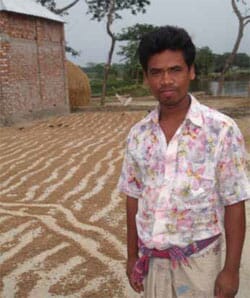
Information services: Feed dealers, retailers and the technical representatives of commercial feed companies provide some embedded services to farmers. Leaflets and booklets are provided, and group discussions and technical advice organized for farmers and dealers. Feed mills also receive embedded services from feed additive suppliers. However, although private information and service provision channels are strong with respect to feeds, services supplied by government and development projects in this area are usually limited or weak.
Regulation
The Feed Act. This Act focuses on a number of key areas, which include: ensuring registration and licensing for all feed producers; making the proximate analysis of feed and accurate labeling of packaging mandatory; regulating feed packaging and storage; ensuring that the macronutrient content of different categories of feed and raw materials is maintained at optimum levels; specifying procedures for macronutrient analysis and record keeping; preventing banned antibiotics and chemicals including pesticides, dyes, mycotoxins and other harmful substances in feeds; stipulating approved feed additives and binders; providing quality monitoring through periodic feed sampling; and inspection in feed mills for compliance with standards.
Breaching these rules is punishable by fines. From 2011 the government moved to register feed mills, and this process has been successfully completed for almost 30 per cent of mills. However, many feed companies are not fully aware of all provisions in the Feed Act. The study found that 20 per cent of feed mills are aware of the Act’s restrictions on antibiotic and chemical use, but are unfamiliar with its other requirements. Importers and suppliers of raw materials and additives for feed are obliged to comply with the Feed Act. They are often unaware of this, but already comply with parts of the Act because of their compliance with customs regulations, many of which are similar. Feed dealers are also frequently unaware of Feed Act regulations, but feed mills require them to comply with registration requirements which are also part of the Feed Act.
Customs regulations. Almost all products imported for use in feeds are exempted from pre-shipment inspection, and almost all raw feed ingredients are duty- and VAT-free. However, before they can be imported, fishmeal and meat and bone meal (MBM) need a certificate indicating that they are free from BSE (Bovine Spongiform Encephalopathy) and TSE (Transmissible Spongiform Encephalopathy). Fishmeal, MBM and all types of feed additives also require radioactive and health certificates from the exporting country. A no-objection certificate (NOC) must also be issued by the Department of Fisheries (DoF) or Department of Livestock Services (DLS) before ingredients can be imported. Although government regulations regarding feeds are strong, there is little implementation of these rules except with respect to customs regulations for product importation.
Social and environmental implications
Almost 10,000 people are estimated to be directly involved in raw material and additive trading, feed production and feed trading. Very few women are involved in the commercial feed production (estimated at less than 3 per cent of the total workforce).The access of small farmers (pond size 0.08–0.1 ha) to feeds is very limited because of unavailable initial investment capacity and credit facilities for purchasing feeds.
Feed production and transport also has environmental implications. Life cycle analysis was used to characterize feed ingredients and the value chain activities according to three impact categories:
- global warming potential;
- acidification potential;
- freshwater and marine eutrophication potential.
This analysis showed higher impacts associated with floating feed production, while lower impacts were associated with locally-produced aquaculture feeds. Production of feed ingredients contributes most significantly to all impacts, with transport and processing less significant. These preliminary results indicate that decisions over feed ingredients govern the larger environmental impacts of feed production, and that possibilities exist to manage ingredients to reduce future impacts. The costs and benefits in the use of agriculture land for production of feed ingredients versus use for human food production remains to be investigated.
Workshop feedback
Fifty stakeholders met in Dhaka on 4 April 2013 to review the major findings and recommendations from the research. Participants in the workshop provided feedback covering a wide range of issues. Farmers stressed the need for better access to credit for feed purchase and the need for improved knowledge of different feeding and culture practices.
Feed producers identified a range of problems, including:
- the need to find alternative power sources to reduce high fuel costs for feed mill operation;
- the need for methods to control ingredient adulteration and maintain feed quality;
- the fluctuation of feed ingredient availability and prices resulting in the use of lower quality alternative raw materials;
- lack of knowledge among feed mill nutritionists on balanced feed formulations and the need to improve feed quality and efficiency;
- the need for training for feed mill engineers to increase machine operation efficiency, and enable them to troubleshoot and select good quality machines;
- the need for quality control labs for testing feeds and raw materials for adulterants such as melamine or antibiotics.
Stakeholders also requested that government legislation of feed raw material and additive imports should be relaxed. They claimed payment of Advanced Income Tax (AIT) on imported raw materials was burdensome, and called for proper monitoring of raw material and feed prices by government and guidelines for maintaining quality.
Conclusions
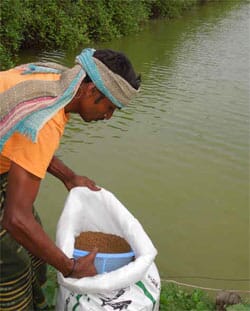
The growth of both commercial aquaculture and commercial fish feed production in Bangladesh over the past 10 years has been significant, and there is considerable room for further expansion of both sectors over the medium to long term, given a growing population with rising incomes and strong cultural preferences for fish consumption. This represents a major strength and opportunity for the feed sector. However, the industry is also confronted by a number of weaknesses and threats. These include the volatile political situation, lack of knowledge on raw material quality, feed formulation, machine operation and selection, a high dependency on imported raw materials, limited implementation of legislation on feeds, and ongoing market consolidation likely to reduce competitiveness in the long run.
The rate of expansion in the production and uptake of manufactured feeds has been so rapid that the industry has yet to mature. It is likely that considerable consolidation will take place over the coming years as farmers become more sophisticated in their feed management and preferences and the benefits of higher quality feeds become more readily apparent—forcing those companies producing inferior products to raise the bar or exit the industry. In the meantime, help is needed to support the aquaculture industry as it continues to expand and modernize. This will entail education for farmers on good quality, guidance for feed manufacturers on manufacturing practices, establishment of proper feed management practices, and enforcement of existing legislation designed to ensure the quality of manufactured feed.
August 2013



